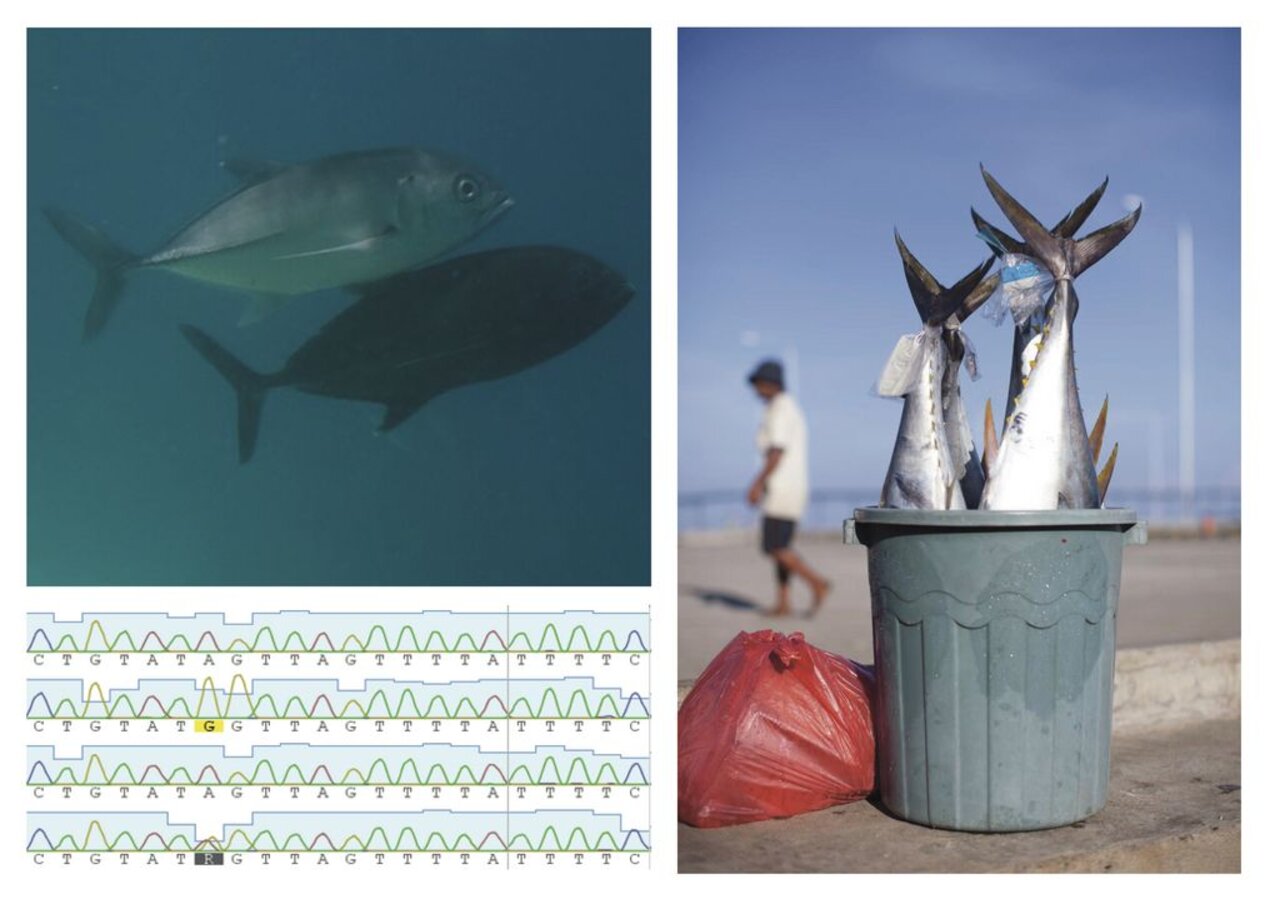Marine Food
Project
Hampering illegal fishing activities and seafood fraud by means of DNA profiling

Development of DNA-based tools for species identification of fish and fisheries products for practical use in the food inspection and import control
A major challenge in the sea food sector is to reliably discriminate between the several hundred commercially traded fish species. Fish species can be notoriously difficult to tell apart, in particular when we have to deal with processed fish such as canned fish, or fish fillets. DNA-based detection tests exhibit a so far underutilized potential to clarify both species identity and origin of questionable fish or fishery products. Such methodologies may help to reveal incorrectly declared fish goods and hinder blurring the traces of fish derived from illegal and unregulated fishing. While transparency and security for retailers and consumers is enhanced, this ultimately increases the level of sustainability in the exploitation of fisheries resources.
Background and Objective
Fish is part of healthy eating for many of us. The demand for fish and fishery products is steadily increasing with the unfortunate consequence that many fish stocks are overfished. However, fisheries resources need to be secured permanently and international agreements were brought into force to regulate fishing activities and the trade of fisheries products between the nations.
Hundreds of species of fish from around the world are imported to Germany. However, mislabeled fish or illegally caught fish are also found on the market. For example, high-priced species are substituted by less expensive species, or pirate fishermen operate within marine protected areas or during closed periods and their illegally caught fish end up in the international trade. Those practices contribute to the decline of sensitive fish stocks and put the consumer´s safety at risk.
A significant step to oppose these developments is the ability to unambiguously reveal species identity and origin of fisheries products. Species identification is traditionally based on morphological features of the fins, overall body shape and coloration. However, geographic origin and similar looking species can hardly be distinguished by those methods. Species identification of processed fish products like fillets is even more difficult because morphological characteristics are no longer available.
Every single animal and plant species differs from any other species in the base sequence of their DNA. Thus, DNA sequence analysis provides efficient ways to identify fish species. However, the majority of the fish species imported to Europe is barely characterized genetically causing molecular genetic techniques to be only rarely applied in food control.
To make DNA sequence analysis an important diagnosis tool of food control, the Thünen-Institute of Fisheries Ecology works on a combined DNA and image database for fish species identification. The project is done in close collaboration with partners from industry, science and customs authorities. The database is already available online (www.aquagene.org) and will be significantly enlarged during this project.
A second project part targets the discrimination of stocks and geographic origin of the bigeye tuna (Thunnus obesus) and the wahoo (Acanthocybium solandri) through high-resolution genetic markers. Both species can be found in many tropical and subtropical marine areas around the world. The bigeye tuna with its highly mobile lifestyle is a textbook example of a migratory fish species that reportedly travels thousands of miles in the open ocean, whereas the wahoo is mainly found in coastal areas. Both species suffer from high fisheries pressure due to their high commercial value. An important aspect of this study is to reveal how those lifestyles affect the stock structure of both species at a global scale, and therefore the possibility of determining geographic origin based on genetic markers.
Approach
The combined DNA and image database for fish species identification includes as many as possible of the approximately 500 fish species currently imported and traded legally in Germany. At least two representative individuals per species will be vouchered with photographs and tissue sample for DNA extraction. The collection of the Thünen-Institute of Fisheries Ecology already holds dozens of vouchered species relevant for this project. Many more species still have to be collected in the field. In the framework of a cooperation with German customs authorities at Frankfurt International airport, questionable import fish will be checked against the reference database and so far unknown/unlisted species will be added to the database if necessary.
Universally occurring DNA fragments which are present in all species, but which exhibit clear differences in the base composition from species to species, are then characterized for each fish species. The species-specific genetic fingerprints will be made public in an online database (www.aquagene.org). Species identity and origin of fish or fishery products may then be reliably detected by comparing those DNA fingerprints of questionable samples with the reference database. This procedure may develop into an extremely useful tool for import controls and for food authorities.
To develop genetic SNP (Single Nucleotide Polymorphism) markers for the stock separation of bigeye tuna and wahoo, the full genome of both species will be sequenced using state-of-the-art DNA sequencing technology. In a first major step, the reference genomes of both species will be assembled. By means of a re-sequencing approach the genomic DNA of dozens of individuals from various marine backgrounds will then be mapped against the reference genome and stock specific SNP markers will be identified. In a complementary approach, the SNP markers will be correlated with data on temperature and salinity to infer processes of local adaptation of the species to varying marine environments.
Data and Methods
DNA extraction; amplification of mitochondrial and nuclear gene fragments by polymerase chain reaction (PCR); Sanger sequencing of the PCR products; expansion of DNA reference database for species identification; creation of a decision support tool for the customs to assign fish species seen during import controls; next-generation sequencing (PacBio, Illumina HiSeq) of bigeye tuna and wahoo genomes, de novo assembly of reference genomes for bigeye tuna and wahoo, whole genome low coverage genome re-sequencing of dozens of individuals of both species; development of SNP markers for stock separation and adaptation to different environmental conditions.
Results
With an import rate of over 80% and a total consumption of over 1 million tons, Germany is one of the most important importing countries for fish and fishery products and thus also bears responsibility for solid import controls not only for food safety for consumers, but also for biodiversity conservation by protecting against illegal, unregulated and undocumented fishing. The further development and optimization of methods for species identification and traceability of fish and fishery products is a central element.
The results from MarineFood make an important contribution here. While the publication of the freely accessible combined gene sequence and image database www.aquagene.org contributes significantly to unambiguous species authentication, the application of a whole genome sequencing approach for the generation of SNP markers for bigeye tuna (Thunnus obesus) and wahoo (Acanthocybium solandri) successfully tested new methods for determining geographical origin and thus traceability. With the validation of 1000 commercial samples from the import control at Frankfurt Airport, specific deficits in fish imports to Germany were shown, mainly because importing incorrectly declared fish from the tropics and subtropics also increases the risk of ciguatera poisoning for consumers.
Thünen-Contact

Involved Thünen-Partners
Involved external Thünen-Partners
-
Universität Oslo, Centre for Ecological and Evolutionary Synthesis
(Oslo, Norwegen) -
Johannes Gutenberg-Universität Mainz
(Mainz, Deutschland) -
Bayerisches Landesamt für Gesundheit und Lebensmittelsicherheit
(Oberschleißheim, Deutschland) -
StarSeq GmbH
(Mainz, Deutschland) - Bundesanstalt für Landwirtschaft und Ernährung (BLE)
(Bonn, Deutschland) -
Perishable Center
(Flughafen Frankfurt Main, Deutschland)
Funding Body
-
Federal Office for Agriculture and Food (BLE)
(national, öffentlich)
Duration
9.2016 - 12.2020
More Information
Project funding number: 2816504114
Project status:
finished
Publications
- 0
Weist P, Kusche H, Torresen OK, Hermida M, Lopes EP, Jentoft S, Hanel R (2024) Genomic differentiation and interoceanic population structure of two large pelagic scombrid species. Global Ecol Conserv 54:e03117, DOI:10.1016/j.gecco.2024.e03117
- 1
Kusche H, Hanel R (2021) Consumers of mislabeled tropical fish exhibit increased risks of ciguatera intoxication: A report on substitution patterns in fish imported at Frankfurt Airport, Germany. Food Contr 121:107647, DOI:10.1016/j.foodcont.2020.107647
- 2
Baalsrud HT, Voja KL, Tørresen OK, Solbakken MH, Matschiner M, Malmstroem M, Hanel R, Salzburger W, Jakobsen KS, Jentoft S (2017) Evolution of hemoglobin genes in codfishes influenced by ocean depth. Sci Rep 7:7956, DOI:10.1038/s41598-017-08286-2

![[Translate to English:] [Translate to English:]](/media/_processed_/2/9/csm_Embryo-Exp_Gelege_9F_dpf5-200513111619_c8534a8199.jpg)
![[Translate to English:] [Translate to English:]](/media/_processed_/2/9/csm_Embryo-Exp_Gelege_9F_dpf5-200513111619_9027994d44.jpg)





